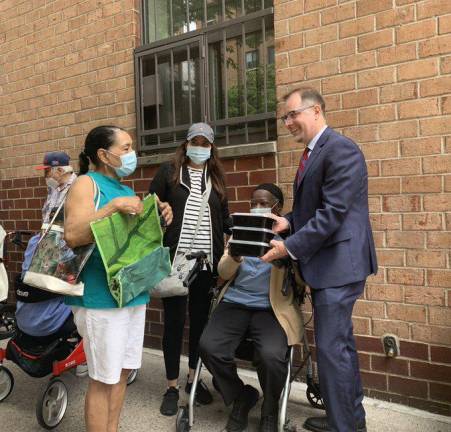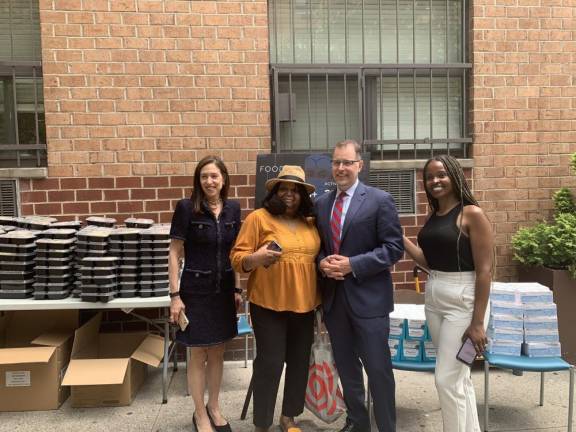Where is My Paxlovid?
After lockdowns and masks, political leaders are leaning on treatments that make COVID less dangerous. But some can be hard to get


Her healthy, 29-year-old nephew in Michigan got Paxlovid when he came down with COVID-19. So did several of her friends, colleagues and a neighbor here in New York. So when she started feeling lousy, and tested positive, Beth Harpaz did the obvious thing.
“I am 61,” she explained. “When I tested positive last Saturday morning, I first googled HHC COVID because a friend’s husband (in his 70s) was able to get a prescription from them. They answered right away on the phone and took me through a screening – age, height, weight (diabetes is as you know, a risk, so I guess they put your height and weight into a chart and see if you are at risk ... I am 5 foot 10 and not overweight so I didn’t make the cut on that for them), and they asked me ‘where have you been hospitalized?’”
Harpaz, an editor, told them the last time she was hospitalized was when she gave birth 25 year ago.
“I had a temp of 101 and a splitting headache and was flat on my back,” she continued, “so I can’t remember much else about the conversation. But at the end of it they said, ‘sorry we can’t prescribe it, you’re not eligible.’ They then said that there are toxicity of the liver potential issues so it’s better not to have Paxlovid unless you need it. OK – so I was slightly incredulous about this.”
Harpaz, who is both sharp and tenacious, didn’t leave it there.
“I almost never go to the doctor because I am basically very healthy and I’m slightly doctor-averse,” Harpaz continued. “But about a year and a half ago I went for my first checkup in six years with a nice doctor at NYU Langone. So I figured, let me just call her answering service and see what happens.”
“It was Saturday morning, and I left a message saying I had COVID and could I get Paxlovid? She called me back and said, ‘I looked through your records and unfortunately there is nothing in your records that makes you eligible’.”
The doctor had apparently reviewed the list distributed by the city and the CDC of 38 conditions that are risk factors that could turn a COVID-19 infection into a life-threatening illness.
“She then gave me basic advice on take fluids, ibuprofen for fever, you are contagious for five days etc.”
Antiviral Treatment
As we settle into year three of the pandemic, political leaders, having moved away from lockdowns and masks, are leaning increasingly on medical interventions that make COVID-19 less dangerous.
One of these, probably second in importance only to vaccination, is Paxlovid, an antiviral treatment from Pfizer that was introduced last December. In clinical trials this treatment was spectacularly effective (88% better than a placebo) in keeping unvaccinated patients from getting seriously ill.
The city has gone to great lengths to make Paxlovid available, creating a pharmacy that can deliver the five-day course of treatment to your home within hours of a positive test, which is essential for effective treatment.
Mayor Eric Adams, a diabetic, took Paxlovid when he caught COVID, and said he had such mild symptoms that he could work out. “When I was hit with COVID, it was just a tickle in my throat,” he said.
Harpaz, who lives in Brooklyn, is one one of a number of New Yorkers who worry that the Mayor’s comments don’t reflect either the potential severity of COVID-19 or the true availability of Paxlovid.
“It’s just too hard to get Paxlovid,” Manhattan Borough President Mark Levine said this week. “There are people who need it who aren’t getting it — especially those who don’t have the resources to navigate a confusing and difficult system. This once again reinforces COVID inequality. We need to open up Paxlovid access ASAP.”
Qualifying Conditions
A survey by the School of Public Health at CUNY found that more than half of COVID patients in New York City had not heard of Paxlovid. Among those who had, distribution was higher among younger, wealthier, better-educated people.
“The current list of qualifying conditions for Paxlovid is long & vague, and not being applied evenly,” Levine added. “Many people whose conditions appear on this list are being denied access. People with resources can try another doctor if they are denied. Most aren’t so lucky.”
The White House said the other day that there were a million courses of Paxlovid available and it would try to ramp up distribution.
“For the first time in our battle against COVID, we have a large supply of an effective antiviral pill,” Levine said. “By removing unnecessary barriers, we can ensure everyone who needs Paxlovid has access. That will be a game changer.”
He recommended that Paxlovid be made available to anyone who wanted it, like Harpaz, even if they don’t meet the test of having one or more risk factors.
“Because the side effects of Paxlovid are so minimal, and supply is strong, the FDA should give everyone the option of accessing it, even if the patient is not strictly ‘high risk’.”
He also urged the FDA to authorize pharmacist to prescribe Paxlovid after a positive test, noting that the biggest risk with Paxlovid is interactions with other drugs, something pharmacists are trained to review.
COVID Hotline
Levine also recommended increasing the staff at the city’s COVID hotline, 212-COVID19, where, he reported, wait times can be 90 minutes (Harpaz said her call was picked up right away on a Saturday morning).
“Our outreach strategies aim to ensure that those most affected are reached,” said a city health department spokesperson, Shari. S. Logan.
The city has worked through community organizations, she said, and newspapers and radio outlets that serve minority neighborhoods so that “New Yorkers have been able to learn about all the basics of the antiviral medication Paxlovid and how to access it.”
“In addition, our COVID-19 hotline for treatments can be accessed by any New Yorker regardless of their insurance status or if they’re a non-English speaker. These are just a couple of ways that we are working to reduce the inequity in access to COVID-19 treatments.”
Pfizer, the manufacturer, has been running a soft sell advertising campaign, just to make patients (or customers, if you prefer) aware that there is a treatment. Because the Food and Drug Administration has given only emergency authorization for Paxlovid, Pifzer isn’t allowed to advertise it directly, in the way that they and other pharmaceutical companies advertise a host of other treatments for less top of mind illnesses.
“COVID-19 moves fast and now you can too,” says the ad. It never mentioned Paxlovid and, in theory, could encourage use of the two other anti-viral treatments given emergency authorization to treat Covid-19, neither of which performed as well in clinical trials. Pfizer says it expects revenue from Paxlovid sales this year to be $22 Billion.
In the meantime, Harpaz has recovered after two weeks of illness and is philosophical about her frustrated quest for Paxlovid.
“I do trust that there are reasons they’re not giving it to everyone,” she said. “It would be great if the mayor understood, in that case, that everyone cannot take a pill and come back to work the next day.”